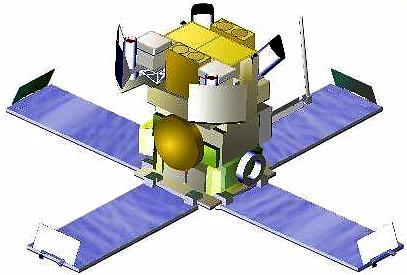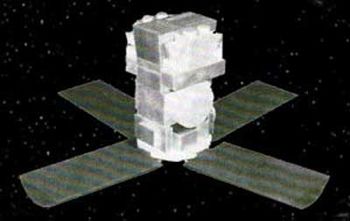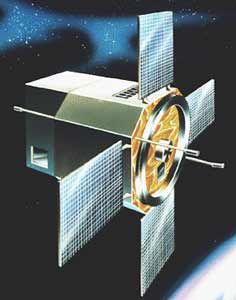
Home - Search - Browse - Alphabetic Index: 0- 1- 2- 3- 4- 5- 6- 7- 8- 9
A- B- C- D- E- F- G- H- I- J- K- L- M- N- O- P- Q- R- S- T- U- V- W- X- Y- Z
HETE

HETE
AKA: High Energy Transient Experiment. Status: Operational 1996. First Launch: 1996-11-04. Last Launch: 2000-10-09. Number: 2 . Gross mass: 124 kg (273 lb). Height: 0.89 m (2.91 ft).
Prime objective was to carry out the first multiwavelength study of gamma ray bursts (GRBs) with UV, X-ray, and gamma ray instruments.
A unique feature of the mission was its capability to localize bursts with several arcsecond accuracy, in near real-time aboard the spacecraft. These positions were transmitted to the ground, and picked up by a global network of primary and secondary ground stations (SGS), enabling sensitive follow-up studies.
The HETE spacecraft measured a meter high by half a meter in diameter. HETE-2 retained most of the original HETE-1 design, with significant modifications made primarily to the power system.
The spacecraft consisted of a spacecraft bus, in which the satellite control hardware and the spacecraft computers reside. The four solar panels (stowed parallel to the spacecraft for launch) were connected at the bottom of the spacecraft bus, and the science instruments point out the top. On orbit, the science instruments always pointed away from the sun, and the deployed solar panels were directed toward the sun.
HETE-2 was equipped with instruments sensitive to gamma- and X-radiation. These instruments shared a common field of view of ~1.5 steradians, spanning a detectable energy range of about 3 decades, and were capable of immediate inter-instrument communication.
The gamma-ray instrument, FREGATE, was sensitive to photons in the 6-400 keV energy range. It provided accurate burst triggers and moderate resolution spectra and was built by the CESR in Toulouse, France.
The wide-field X-ray Monitor (WXM) was sensitive in the 2-25 keV energy range, with good energy resolution and localization accuracy to ~10 arc-minutes or better. The WXM detectors were built by RIKEN.
The soft X-ray camera (SXC) was sensitive in the 0.5-10 keV energy range, with very good energy resolution and localization accuracy to 30 arc-seconds or better. The SXC was built by the Center for Space Research at MIT
Each HETE-2 instrument operated independently of the others; however, if a burst was detected by one of the instruments, the others were notified and began collecting data at higher temporal and energy resolution. All instruments utilized on board sensors to determine safe and appropriate operational conditions.
The control of the attitude of the spacecraft was the responsibility of the ACS (Attitude Control System) algorithms in the spacecraft computer. The inputs to the ACS were from: 1) two magnetometers, one on the spacecraft body, and one on one of the solar panels; 2) a set of twelve coarse, medium, and fine sun sensors, which tell where the sun in in their fields-of-view; and 3) the optical camera system, which delivered spacecraft drift rate information during orbit night.
Control of spacecraft attitude was done with: 1) three orthogonal torque coils, which used electrical currents in the coils to generate IxB forces around the Earth's magnetic field; 2) a momentum wheel, which nominally spun at roughly 1800 RPM and which could be torqued to change the angular momentum of the spacecraft.
The ACS software consisted of a sophisticated set of algorithms which take the current spacecraft orientation and spin and adjusts the torque coil currents and wheel momentum to create a stable orientation.
The communications system hardware complement consisted of: 1) an S-band radio, transmitting and receiving at frequencies near 2 GHz, which was used for uplink and downlink of spacecraft data; 2) 5 dual patch transmit-receive S-band antennae, four of which were oriented on the tips of the solar panels and one on the "bottom" (sun-facing side) of the spacecraft, 3) a VHF transmitter, which was used to transmit (only) important scientific and spacecraft-related housekeeping to the ground; 4) a "whip" antenna for the VHF, mounted to one of the solar panels.
The HETE-2 power system hardware consisted of: 1) four solar panels, made of honeycomb aluminum with silicon substrate, each supplying 42W; 2) power box with power point tracker; 3) ~90% efficient 6 battery packs, each made up of a string of 24 1.5V NiCd cells, and each with 1.2 A-hrs capacity
The power box had a sophisticated design which allowed it to charge the batteries ("net positive charging") regardless of orientation or panel deployment state, when the spacecraft was in "safe-hold mode": the safe-hold power was 2W, while the minimum charging power was 7W.
The spacecraft computer system consisted of four identical processor boards: each board contained one T805 transputer, two Motorola 56001 DSPs, and 20 Mbytes of RAM. The processors were assigned to the spacecraft and science needs in the following way: #1: spacecraft processing; #2: SXC; #3: optical cameras; #4: WXM and Fregate. The "links" feature of the transputer allowed for quick and efficient communications between processors. The DSPs serve as the interface to the instruments.
The Radiation Belt Monitor (RBM) detected energetic protons and electrons (with energies > 1 MeV) in low-Earth orbit. Because such particle radiation could damage the spacecraft hardware (especially the WXM), the RBM was monitored for high particle flux, at which time the instruments were turned off.
The Global Positioning System (GPS) receiver, provided by CNES, was used to measure the precise position of HETE-2 on orbit and to provide a good mapping of spacecraft time to UTC.
Spacecraft Specifications
Mass: 124 kg. Envelope: Fitted within cylinder 89cm x 66 cm diameter. Desired orbit: 625 km circular, 0-2 degree inclination Operating life: 18 months, nothing to preclude 2+ years Attitude: Sun pointing. Momentum bias. Attitude controlled to +/- 2 degrees Data processing: 4 T805 transputers, 8 DSP56001, ~ 100 Mips Data Buffering: 96 MBytes of EDAC mass memory Downlink: 250 kbits/sec data rate with overall bit error rate < 2x10-8 from data storage to ground archive. Uplink: 31.25 kbits/sec data rate, overall bit error rate < 10-8 Radio Frequencies: S-band uplink (2.092 GHz) and downlink (2.272 GHz) for primary ground stations, VHF downlink only (137.9622 MHz) for burst alert stations
HETE was a sun pointing, momentum biased spacecraft with attitude controlled to +/- 2 degrees by magnetic torque coils. Actual spacecraft attitude could be determined to within +/- 30 arcminutes with onboard sensors. HETE's multi-processor architecture ran at 80 VAX MIPS with 96 MBytes of EDAC mass memory available for data buffering.
Telemetry could be sent/received from three primary ground stations located in Haystack, Mass. , Miyazaki, Japan, and Toulouse, France. S-band uplink was designed for 31.25 kbit/s throughput at 2.092 GHz. Downlink was designed for 250 kbit/s at 2.272 GHz. A network of receive-only secondary ground stations were designed to immediately alert researchers to transient outbursts, thus increasing the chance of observing the event with ground-based telescopes. Transmission occurred in the VHF at 137.9622 MHz. The VHF link could also transmit spacecraft telemetry in the event of an onboard emergency.
HETE provided multiwavelength coverage of high energy transients with three different instruments. Each was capable of operating independently of the other, but during orbit night, when all three instruments operated, the detection of a transient by one instrument would result in collection of data in all three energy bands. The French Gamma Telescope (FREGATE) handled the detection and spectroscopy of gamma-ray bursts and monitors variable X-ray sources. The Wide-Field X-Ray Monitor (WXM), built by a team of Japanese and U. S. Scientists from Riken and Los Alamos National Labs was the prime instrument for detecting X-ray sources. Four Ultraviolet CCD cameras were built by MIT's Centre for Space Research. Three were of identical design, one had an optical filter. In addition to providing the most accurate directional information about transient events, the UV cameras assisted with spacecraft attitude determination. The 1024x1024 pixel CCD's were fabricated by MIT's Lincoln Labs. HETE hardware and software were designed to allow the satellite to operate with virtually no commands from the ground. All instruments could be configured to allow for completely autonomous observations, using on board sensors to determine safe and appropriate operational conditions.
The HETE spacecraft reached a nominal orbit on 4 November 1996, along with its piggybacked partner, SAC-B. However, the two spacecraft were not ejected from the Orbital Sciences Corporation Pegasus XL rocket as planned. Telemetry indicated a power failure in the transient power bus of the Pegasus third stage, causing the failure of 3 crucial pyrotechnics to ignite. Thus, HETE remained enclosed in OSC's Dual Payload Attachment Fitting (DPAF). On the morning of 5 November, operators of a 23m VHF antenna at Wallops Island did receive a transmission while monitoring a frequency used by HETE's emergency beacon. The modulation and duty cycle were correct. Subsequent passes at Los Alamos National Lab and Wallops Island also picked up a similar though much weaker signal. Unable to deploy solar panels to charge it's batteries, the HETE spacecraft expired several days after launch. The relevance of the HETE mission was not diminished with the loss of the satellite. The resolution of the mystery of gamma ray bursts remained a high priority in X-ray astronomy, and the HETE team pursued its resurrection. This came to pass in 2000 when HETE-2 was launched.
NASA NSSDC Master Catalog Description
The High Energy Transient Explorer 2 (HETE-2) is designed to detect cosmic gamma-ray bursts (GRBs) and help determine their origin and nature. The satellite has three instruments: 1) a set of wide-field gamma-ray (6 - 400 keV) spectrometers (FREGATE); 2) a wide-field X-ray (2 - 25 keV) monitor (WXM), and 3) a set of soft X-ray (0.5 - 10 keV) cameras (SXC). These instruments cover a solid angle of 1.5-2 steradians and will be used to make simultaneous, broad-band observations in the various listed energy ranges. The goal of the mission is to continuously scan the sky and identify occurences of GRBs, establish precise locations and transmit coordinates in near real time (< 10 seconds). The instruments will also be used to establish relative GRB rates and intensities in the soft X-ray, mid X-ray, and gamma-ray bands, perform spectroscopy of gamma-ray bursts in the energy range 1-400 keV, measure the intensities, time histories, and spectra of soft gamma-ray repeater bursts, X-ray bursts, and black hole X-ray transients.
The spacecraft is basically a rectangular cube, roughly one meter by half a meter by half a meter, with four solar panel petals protruding from the bottom. The bottom section of the spacecraft holds the power, communications, and attitude control and the upper section the science instruments. Power is supplied by the solar panels, which are made of honeycomb aluminum with a silicon substrate, each supplying 42 W. There are 6 battery packs, each containing 24 1.5 V NiCd cells, each with 1.2 A-hr capacity. Communication is via S-band uplink (2.092 GHz) and downlink (2.272 GHz) using 5 dual-patch antennas. A VHF downlink (137.9622 MHz) will be used for the real-time burst alerts via a whip antenna mounted on one of the solar panels. Attitude control is achieved by a momentum wheel and three orthogonal magnetic torque coils, controlled by inputs from two magnetometers, twelve sun sensors, and an optical camera.
HETE-2 will be placed in a 592 km x 640 km elliptical Earth orbit. The spacecraft will always be pointed in the anti-solar direction and all bursts detected will be at least 120 degrees from the Sun. The field of view will be centered roughly on the ecliptic. Over the course of a year approximately 60% of the sky will be surveyed. When GRB's are detected, summary burst data are sent immediately to listen-only equatorial ground stations and are forwarded to observers via the GRB coordinates network within less than 10 seconds of burst detection. The planned operating life is 18 months with probable mission extensions for an additional 6 months or more.
More at: HETE.
| TERRIERS American earth ionosphere satellite. Atmospheric Research satellite built by AeroAstro for NASA, USA. Launched 1999. Used HETE-Bus, spin stabilized. |
Family: Astronomy, Gamma ray astronomy satellite, Medium earth orbit. Country: USA. Launch Vehicles: Pegasus, Pegasus XL, Pegasus H. Projects: STEDI. Launch Sites: Wallops Island DZ, Kwajalein DZ. Agency: AeroAstro, MIT. Bibliography: 2, 4, 552, 554, 6558, 12537.
 | HETE Credit: Manufacturer Image |
 | HETE Credit: Manufacturer Image |
 | HETE-2 Credit: Manufacturer Image |
1996 November 4 - . 17:08 GMT - . Launch Site: Wallops Island. Launch Complex: Wallops Island DZ. Launch Pad: RW04/22. Launch Platform: L-1011. LV Family: Pegasus. Launch Vehicle: Pegasus XL. FAILURE: The rocket functioned perfectly but the separation system failed to release the payload.. Failed Stage: P.
- HETE - .
Mass: 124 kg (273 lb). Nation: USA.
Agency: NASA Greenbelt.
Program: STEDI.
Class: Astronomy.
Type: X-ray astronomy satellite. Spacecraft: HETE.
Decay Date: 2002-04-07 . USAF Sat Cat: 24645 . COSPAR: 1996-061A. Apogee: 555 km (344 mi). Perigee: 487 km (302 mi). Inclination: 38.00 deg. Period: 95.00 min.
The High Energy Transient Experiment (HETE) was an international mission led by The Massachusetts Institute of Technology (MIT). Its prime objective was to carry out the first multiwavelength study of gamma ray bursts (GRBs) with UV, X-ray, and gamma ray instruments. A unique feature of the mission was its capability to localise bursts with several arcsecond accuracy, in near real-time aboard the spacecraft. These positions were to be transmitted to the ground, and picked up by a global network of primary and secondary ground stations (SGS), enabling sensitive follow-up studies. However the satellite was never released from its payload fitting. Although signals were received, the solar panels could not deploy, and it went silent after a few days when its batteries ran down. Air dropped in Wallops Island DZ.
1999 May 18 - . 05:09 GMT - . Launch Site: Point Arguello. Launch Complex: Point Arguello WADZ. Launch Pad: Aircraft from Vandenberg.. Launch Platform: L-1011. LV Family: Pegasus. Launch Vehicle: Pegasus XL/HAPS.
- TERRIERS - .
Nation: USA.
Agency: NASA Greenbelt.
Manufacturer: AeroAstro.
Class: Technology.
Type: Military technology satellite. Spacecraft Bus: HETE.
Spacecraft: TERRIERS.
USAF Sat Cat: 25735 . COSPAR: 1999-026A. Apogee: 493 km (306 mi). Perigee: 484 km (300 mi). Inclination: 97.10 deg. Period: 94.40 min.
TERRIERS was part of NASA's Student Explorer Demonstration Initiative (STEDI), which was a precursor program to the UNEX (University Explorer) series. STEDI was managed by USRA (the Universities Space Research Association) for NASA, while UNEX was to be more directly managed by NASA-GSFC. TERRIERS was to be operated by the space physics group at Boston University for ionosphere studies, and carried TESS, a set of extreme ultraviolet (EUV) spectrographs to get electron density and thermosphere emission profiles. The GISSMO instrument measured the solar EUV flux. The spacecraft was built by AeroAstro and based on HETE. TERRIERS was placed in the correct orbit, but it failed to orient its solar panel to the Sun and ran out of battery power by May 20. Controllers were optimistic that when its orbit processes to a better sun angle the satellite could be revived. Air dropped in Point Arguello WADZ. Additional Details: here....
2000 October 9 - . 05:38 GMT - . Launch Site: Kwajalein. Launch Complex: Kwajalein DZ. Launch Pad: RW06/24. Launch Platform: L-1011. LV Family: Pegasus. Launch Vehicle: Pegasus H.
- HETE-2 - .
Mass: 130 kg (280 lb). Nation: USA.
Agency: NASA Greenbelt.
Manufacturer: MIT.
Class: Astronomy.
Type: X-ray astronomy satellite. Spacecraft: HETE.
USAF Sat Cat: 26561 . COSPAR: 2000-061A. Apogee: 641 km (399 mi). Perigee: 598 km (372 mi). Inclination: 1.95 deg. Period: 97.02 min.
First orbital launch from Kwajalein. Second High Energy Transient Explorer; built by MIT using leftover parts from the first HETE. This failed to operate because of a Pegasus adapter failure during launch in November 1996. MIT operates the satellite, while the program is managed by NASA GSFC as an Explorer mission of opportunity. HETE's main instrument is FREGATE, the French Gamma Telescope, a hard X-ray spectrometer operating in the 6 to 400 keV energy range. This gamma ray burst detector, together with a Wide Field X-ray Monitor hard X-ray coded mask telescope, is used to trigger searches with the two Soft X-ray Imagers which have 33-arcsecond spatial resolution. This will let astronomers get precise locations for gamma-ray bursts, allowing detailed follow-up with optical instruments. The satellite is in a 595 x 636 km x 2.0 deg equatorial orbit, and sends data to a network of small ground terminals spaced around the equator. Air dropped in Kwajalein DZ.
2002 April 6 - .
Back to top of page
Home - Search - Browse - Alphabetic Index: 0- 1- 2- 3- 4- 5- 6- 7- 8- 9
A- B- C- D- E- F- G- H- I- J- K- L- M- N- O- P- Q- R- S- T- U- V- W- X- Y- Z
© 1997-2019 Mark Wade - Contact
© / Conditions for Use